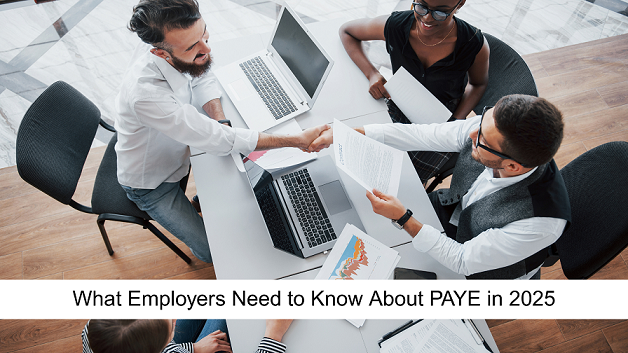
PAYE is the system where employers take Income Tax and National Insurance from their employees’ pay before they get it. In 2025, employers need to know about new tax codes like 1257L, changes to National Insurance rates, and the need to report pay correctly to HMRC using payroll software.
These changes came into effect from 6th April 2025. Employers need to stay informed and update their payroll processes accordingly to comply with HMRC rules. Using the right software and understanding updated thresholds and rates will help avoid errors, penalties, and keep payroll running smoothly throughout the year.
What is PAYE?
PAYE stands for Pay As You Earn. It is the system employers use to take income tax and National Insurance from their employees’ wages before they receive their pay.
Every month, employers deduct the correct amount of tax and send it to HMRC through PAYE. So, if someone asks what is PAYE, simply remember it is the way tax is taken from your pay before it reaches you.
In 2025, there are important updates to PAYE that employers need to know. From tax rates and National Insurance thresholds to new reporting rules, staying informed helps you manage payroll correctly and meet HMRC requirements easily.
Employers have to use HMRC payroll software and report employee payments every time they pay their staff. If you’re new, you must register for HMRC payee online and get set up.
The 1257L tax code is the most common in the UK. It means an employee has a tax-free Personal Allowance of £12,570 for the year. Employees with this code don’t pay tax on the first £12,570 they earn, and any income above that is taxed at the normal rates. The “L” shows they are entitled to the standard personal allowance with no special adjustments.
Here is a list of common tax codes used in 2025 and what each one means. Understanding these codes helps employers know how much tax to take from their employees’ pay.
|
Tax Code |
What It Means |
|
1257L |
Standard code, full £12,570 tax-free |
|
S1257L |
Scottish employee, standard allowance |
|
C1257L |
Welsh employee, standard allowance |
|
BR |
All pay is taxed at 20% (usually 2nd job) |
|
DO |
All pay is taxed at 40% |
|
D1 |
All pay is taxed at 45% |
|
0T |
No personal allowance, all pay is taxed |
|
NT |
No tax taken (used in special cases) |
HMRC may add “W1”, “M1”, or “X” to a code; these are emergency codes for new starters.
Paying HMRC PAYE properly is essential for every employer. Following the right steps ensures your tax payments are accurate, on time, and helps you avoid fines.
If you run a business, it’s important to understand how PAYE works and what can affect it. Here are some easy tips to help you handle tax codes, allowances, and employee benefits the right way
Understanding PAYE is crucial for every employer to ensure the correct tax and National Insurance contributions are deducted and paid to HMRC. Staying updated with the latest tax codes, rates, and reporting requirements for 2025 helps you avoid mistakes and penalties.
Using HMRC-approved payroll software and keeping accurate records will make managing PAYE easier and keep your business compliant. By following these guidelines and tips, you can confidently handle PAYE and focus on running your business smoothly.
Managing PAYE can be challenging, but PHS Associates is here to support you. Our expert payroll and tax services ensure that your PAYE deductions for 2025 are handled accurately and efficiently, helping you stay compliant with HMRC rules.
If you need clear guidance on PAYE tax codes, National Insurance rates, or reporting requirements, contact PHS Associates at 0208 8611685 or email info@phs-uk.co.uk. We simplify PAYE management so you can focus on running your business without worrying about payroll mistakes or penalties. Trust us to keep your PAYE processes smooth and stress-free in 2025.